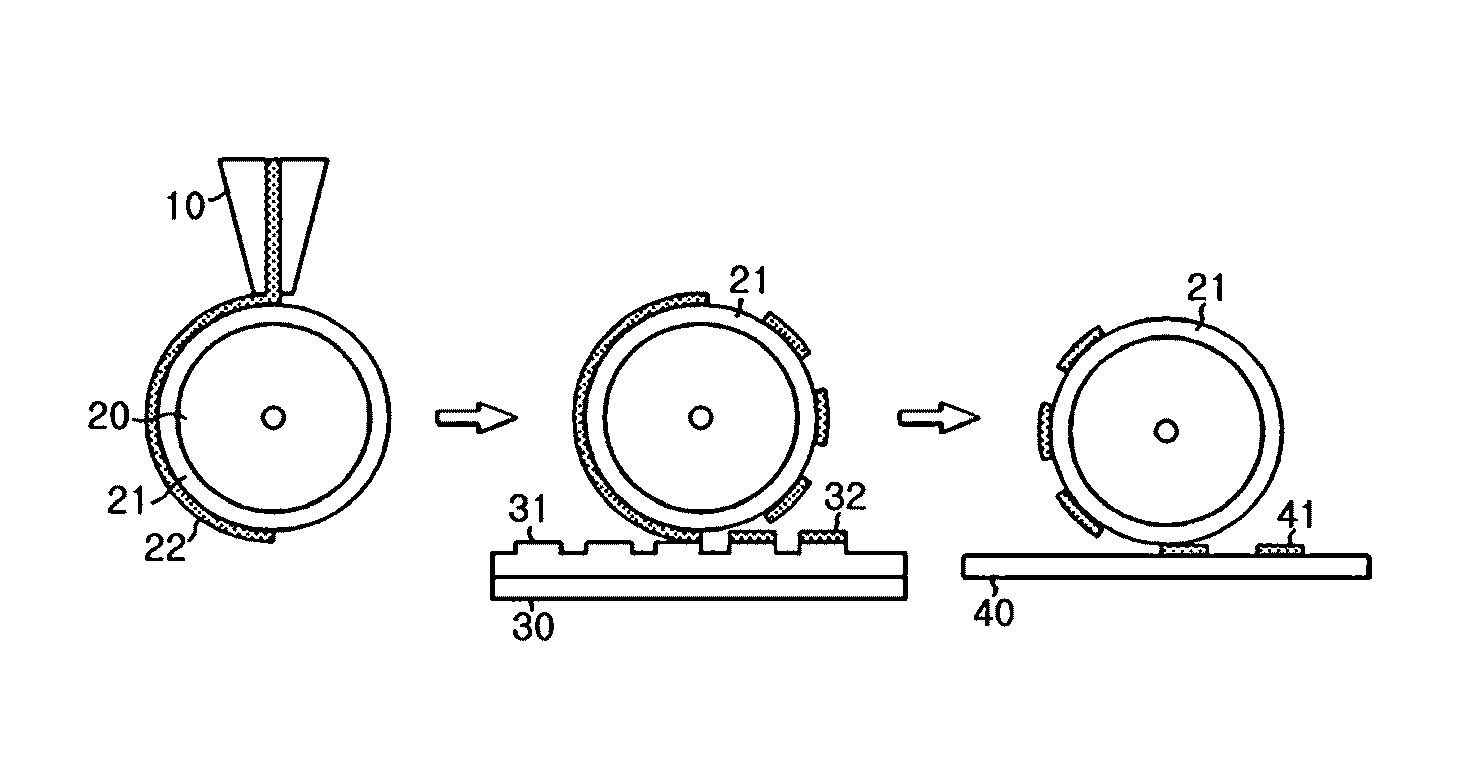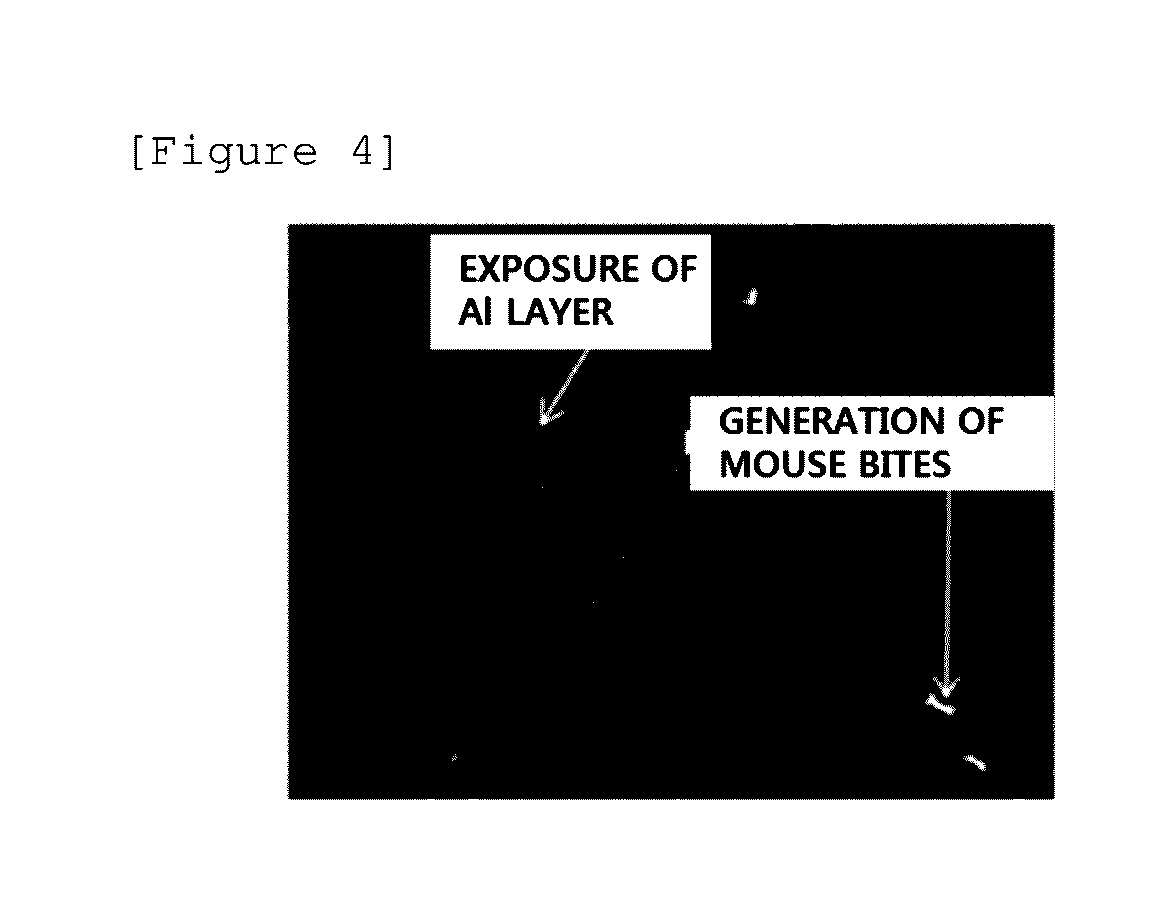Offset printing composition, printing method using same, and pattern comprising offset printing composition
a technology of offset printing and composition, which is applied in the direction of printing, printing circuits, inks, etc., can solve the problems of increasing manufacturing costs, complicated manufacturing process, and large amount of harmful chemical wastes to the environment, and achieves excellent adhesion, reduce residues, and improve the effect of transfer characteristics
- Summary
- Abstract
- Description
- Claims
- Application Information
AI Technical Summary
Benefits of technology
Problems solved by technology
Method used
Image
Examples
example 1
[0083]A printing composition was prepared by dissolving 10 g of a novolac resin having a polystyrene-converted weight average molecular weight of 4,000 prepared by mixing m-cresol and p-cresol at a weight ratio of 5:5, 1 g of a transfer and adhesion improving agent pyrogallol, and 0.4 g of a surfactant in 83.6 g of a low-boiling point solvent ethanol and 5 g of a high-boiling point solvent 1,4-butanediol, and then filtering the resulting mixture with a filter having an aperture of 1 μm. For the prepared printing composition, the measurement of front transfer rate, the evaluation of residue generation, the evaluation of etching, the measurement of pattern precision, and the evaluation of continuous printing characteristics were performed by the methods of the following Experimental Examples 1 to 5.
example 2
[0084]A printing composition was prepared by dissolving 10 g of a novolac resin having a polystyrene-converted weight average molecular weight of 4,000 prepared by mixing m-cresol and p-cresol at a weight ratio of 5:5, 1 g of a transfer and adhesion improving agent 5-methylpyrogallol, and 0.4 g of a surfactant in 83.6 g of a low-boiling point solvent ethanol and 5 g of a high-boiling point solvent 1,4-butanediol, and then filtering the resulting mixture with a filter having an aperture of 1 μm. For the prepared printing composition, the measurement of front transfer rate, the evaluation of residue generation, the evaluation of etching, the measurement of pattern precision, and the evaluation of continuous printing characteristics were performed by the methods of the following Experimental Examples 1 to 5.
example 3
[0085]A printing composition was prepared by dissolving 10 g of a novolac resin having a polystyrene-converted weight average molecular weight of 4,000 prepared by mixing m-cresol and p-cresol at a weight ratio of 5:5, 1 g of a transfer and adhesion improving agent 5-ethylpyrogallol, and 0.4 g of a surfactant in 83.6 g of a low-boiling point solvent ethanol and 5 g of a high-boiling point solvent 1,4-butanediol, and then filtering the resulting mixture with a filter having an aperture of 1 μm. For the prepared printing composition, the measurement of front transfer rate, the evaluation of residue generation, the evaluation of etching, the measurement of pattern precision, and the evaluation of continuous printing characteristics were performed by the methods of the following Experimental Examples 1 to 5.
PUM
| Property | Measurement | Unit |
|---|---|---|
| boiling point | aaaaa | aaaaa |
| boiling point | aaaaa | aaaaa |
| width | aaaaa | aaaaa |
Abstract
Description
Claims
Application Information
 Login to View More
Login to View More - R&D
- Intellectual Property
- Life Sciences
- Materials
- Tech Scout
- Unparalleled Data Quality
- Higher Quality Content
- 60% Fewer Hallucinations
Browse by: Latest US Patents, China's latest patents, Technical Efficacy Thesaurus, Application Domain, Technology Topic, Popular Technical Reports.
© 2025 PatSnap. All rights reserved.Legal|Privacy policy|Modern Slavery Act Transparency Statement|Sitemap|About US| Contact US: help@patsnap.com



